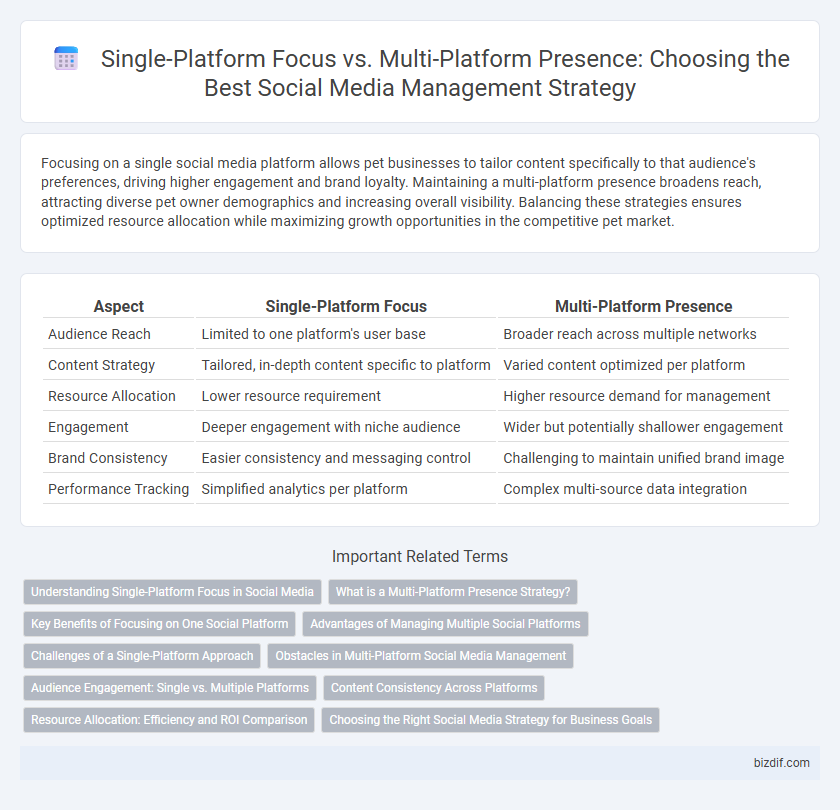Focusing on a single social media platform allows pet businesses to tailor content specifically to that audience's preferences, driving higher engagement and brand loyalty. Maintaining a multi-platform presence broadens reach, attracting diverse pet owner demographics and increasing overall visibility. Balancing these strategies ensures optimized resource allocation while maximizing growth opportunities in the competitive pet market.
Table of Comparison
| Aspect | Single-Platform Focus | Multi-Platform Presence |
|---|---|---|
| Audience Reach | Limited to one platform's user base | Broader reach across multiple networks |
| Content Strategy | Tailored, in-depth content specific to platform | Varied content optimized per platform |
| Resource Allocation | Lower resource requirement | Higher resource demand for management |
| Engagement | Deeper engagement with niche audience | Wider but potentially shallower engagement |
| Brand Consistency | Easier consistency and messaging control | Challenging to maintain unified brand image |
| Performance Tracking | Simplified analytics per platform | Complex multi-source data integration |
Understanding Single-Platform Focus in Social Media
Single-platform focus in social media management allows brands to deepen engagement by tailoring content specifically to the unique audience and algorithm of one platform, such as Instagram or LinkedIn. Concentrating efforts on a single channel enhances brand consistency, optimizes resource allocation, and enables more precise performance tracking through platform-specific analytics. Businesses leveraging a single-platform strategy often achieve higher quality interactions and stronger community building compared to spreading content across multiple networks.
What is a Multi-Platform Presence Strategy?
A multi-platform presence strategy involves managing and optimizing brand visibility across various social media channels such as Facebook, Instagram, Twitter, LinkedIn, and TikTok to reach diverse audience segments. This approach leverages platform-specific content tailored to user behavior, increasing engagement rates and broadening market reach. Effective multi-platform social media management tools and analytics enable cohesive brand messaging and performance tracking across all channels.
Key Benefits of Focusing on One Social Platform
Focusing on a single social media platform allows for deeper audience engagement by tailoring content specifically to user preferences and platform algorithms, leading to higher interaction rates and stronger community building. This concentrated approach optimizes resource allocation, reducing time and costs associated with managing multiple accounts while maximizing content quality and consistency. Enhanced data analytics from a single platform enable precise performance tracking and strategy refinement, driving more effective marketing outcomes.
Advantages of Managing Multiple Social Platforms
Managing multiple social media platforms increases brand visibility by reaching diverse audiences across channels such as Facebook, Instagram, Twitter, and LinkedIn. It enhances customer engagement by tailoring content to platform-specific user behaviors, boosting interaction rates and community growth. A multi-platform presence also provides comprehensive analytics insights, enabling data-driven strategies to optimize marketing efforts and improve ROI.
Challenges of a Single-Platform Approach
A single-platform social media approach limits audience reach and hinders brand visibility, restricting growth potential in diverse market segments. Dependence on one platform increases vulnerability to algorithm changes, policy updates, or technical issues that can abruptly decrease engagement and traffic. This strategy also constrains content format flexibility and reduces opportunities for cross-platform audience interaction and data insights essential for effective marketing optimization.
Obstacles in Multi-Platform Social Media Management
Managing multiple social media platforms presents challenges such as inconsistent brand messaging, increased time investment, and the complexity of tailoring content to diverse audiences. Each platform has unique algorithms, posting schedules, and engagement metrics that require specialized strategies, often overwhelming small teams. Tools for automation and analytics exist but may not fully address the nuanced demands of cross-platform coordination, leading to potential drops in user engagement and ROI.
Audience Engagement: Single vs. Multiple Platforms
Focusing on a single social media platform allows brands to tailor content specifically to that audience, resulting in deeper engagement and stronger community building. Managing multiple platforms broadens reach and diversifies audience interaction but requires consistent, platform-specific strategies to maintain engagement quality. Data shows single-platform campaigns yield up to 30% higher engagement rates, while multi-platform approaches enhance overall brand visibility and cross-channel audience growth.
Content Consistency Across Platforms
Maintaining content consistency across platforms enhances brand recognition and audience trust by delivering a unified message tailored to each platform's unique format and user behavior. Single-platform focus allows deeper engagement and specialized content optimization, while multi-platform presence broadens reach and increases opportunities for audience interaction across diverse demographics. Strategic alignment of tone, visuals, and posting schedules ensures cohesive brand storytelling, maximizing the effectiveness of social media management efforts.
Resource Allocation: Efficiency and ROI Comparison
Concentrating social media efforts on a single platform maximizes resource allocation efficiency, enabling deeper audience engagement and tailored content strategies that typically yield higher ROI. In contrast, managing a multi-platform presence requires dividing time, budget, and creative assets, often diluting impact and increasing operational complexity without guaranteed proportional returns. Brands prioritizing ROI should analyze platform-specific metrics and audience overlap to optimize investment and drive scalable growth.
Choosing the Right Social Media Strategy for Business Goals
Choosing the right social media strategy requires aligning platform selection with specific business goals, where a single-platform focus allows for deep audience engagement and content customization on channels like Instagram or LinkedIn. Multi-platform presence enhances brand visibility and reach by engaging diverse demographics across Facebook, Twitter, TikTok, and Pinterest. Businesses should evaluate target audience behavior, content capabilities, and resource availability to decide between concentrated efforts or broader outreach for optimal ROI.
Single-platform focus vs multi-platform presence Infographic

 bizdif.com
bizdif.com